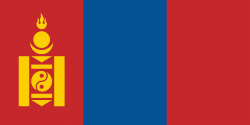Flag of Mongolia
The national flag of Mongolia (Монгол улсын төрийн далбаа, ) is a vertical triband with a red stripe at each side and a blue stripe in the middle, with the Mongolian Soyombo symbol centering on the leftmost stripe. The blue stripe represents the eternal blue sky, and the red stripes thriving for eternity. The Soyombo symbol is a geometric abstraction that represents fire, sun, moon, earth, water, and a Taijitu symbol representing the duality of yin and yang.
The current flag was adopted on 12 January 1992, with the current official colour standards being set on 8 July 2011. Until 1992, the flag had a communist star above the Soyombo, during the final 47 years of the Mongolian People's Republic. The flag was originally designed by artist Dodiin Choidog (Додийн Чойдог).
It has become common practice among Mongolians in the Inner Mongolia autonomous region to hang the Mongolian flag, although the Chinese government is allegedly against public displays of Mongolian national or cultural symbols due to concerns of separatism.
The current flag was adopted on 12 January 1992, with the current official colour standards being set on 8 July 2011. Until 1992, the flag had a communist star above the Soyombo, during the final 47 years of the Mongolian People's Republic. The flag was originally designed by artist Dodiin Choidog (Додийн Чойдог).
It has become common practice among Mongolians in the Inner Mongolia autonomous region to hang the Mongolian flag, although the Chinese government is allegedly against public displays of Mongolian national or cultural symbols due to concerns of separatism.
National flag
Country - Mongolia
Warning: getimagesize(/Image/Map/MP2029969.gif): failed to open stream: No such file or directory in /home/mapnlee7/public_html/MAPNALL/article.php on line 532
 |
The territory of modern-day Mongolia has been ruled by various nomadic empires, including the Xiongnu, the Xianbei, the Rouran, the First Turkic Khaganate, and others. In 1206, Genghis Khan founded the Mongol Empire, which became the largest contiguous land empire in history. His grandson Kublai Khan conquered China proper and established the Yuan dynasty. After the collapse of the Yuan, the Mongols retreated to Mongolia and resumed their earlier pattern of factional conflict, except during the era of Dayan Khan and Tumen Zasagt Khan. In the 16th century, Tibetan Buddhism spread to Mongolia, being further led by the Manchu-founded Qing dynasty, which absorbed the country in the 17th century. By the early 20th century, almost one-third of the adult male population were Buddhist monks. After the collapse of the Qing dynasty in 1911, Mongolia declared independence, and achieved actual independence from the Republic of China in 1921. Shortly thereafter, the country became a satellite state of the Soviet Union, which had aided its independence from China. In 1924, the Mongolian People's Republic was founded as a socialist state. After the anti-communist revolutions of 1989, Mongolia conducted its own peaceful democratic revolution in early 1990. This led to a multi-party system, a new constitution of 1992, and transition to a market economy.
